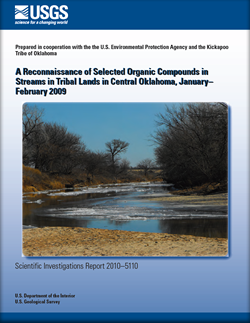Scientific Investigations Report 2010–5110

The U.S. Geological Survey worked in cooperation with the U.S. Environmental Protection Agency and the Kickapoo Tribe of Oklahoma on two separate reconnaissance projects carried out concurrently. Both projects entailed the use of passive samplers as a sampling methodology to investigate the detection of selected organic compounds at stream sites in jurisdictional areas of several tribes in central Oklahoma during January–February 2009. The focus of the project with the U.S. Environmental Protection Agency was the detection of pesticides and pesticide metabolites using Semipermeable Membrane Devices at five stream sites in jurisdictional areas of several tribes. The project with the Kickapoo Tribe of Oklahoma focused on the detection of pesticides, pesticide metabolites, polycyclic aromatic hydrocarbons, polychlorinated biphenyl compounds, and synthetic organic compounds using Semipermeable Membrane Devices and Polar Organic Chemical Integrative Samplers at two stream sites adjacent to the Kickapoo tribal lands. The seven stream sites were located in central Oklahoma on the Cimarron River, Little River, North Canadian River, Deep Fork, and Washita River. Extracts from SPMDs submerged at five stream sites, in cooperation with the U.S. Environmental Protection Agency, were analyzed for 46 pesticides and 6 pesticide metabolites. Dacthal, a pre-emergent herbicide, was detected at all five sites. Pendimethalin, also a pre-emergent, was detected at one site. The insecticides chlorpyrifos and dieldrin were detected at three sites and p,p'-DDE, a metabolite of the insecticide DDT, also was detected at three sites. SPMDs and POCIS were submerged at the upstream edge and downstream edge of the Kickapoo tribal boundaries. Both sites are downstream from the Oklahoma City metropolitan area and multiple municipal wastewater treatment plants. Extracts from the passive samplers were analyzed for 62 pesticides, 10 pesticide metabolites, 3 polychlorinated biphenyl compounds, 35 polycyclic aromatic hydrocarbons, and 49 synthetic organic compounds. Ten pesticides and four pesticide metabolites were detected at the upstream site and seven pesticides and four pesticide metabolites were detected at the downstream site. Pesticides detected at both sites were atrazine, chlorpyrifos, dacthal, dieldrin, metolachlor, pendimethalin, and trans-nonachlor. Additionally at the upstream site, heptachlor, pentachlorophenol, and prometon were detected. The pesticide metabolites p,p'-DDE, cis-chlordane, and trans-chlordane also were detected at both sites. Polychlorinated biphenyl compounds aroclor-1016/1242, aroclor-1254, and aroclor-1260 were detected at both sites. The upstream site had 16 polycyclic aromatic hydrocarbon detections and the downstream site had 8 detections. Because of chromatographic interference during analysis, a positive identification of 17 polycyclic aromatic hydrocarbons could not be made. Consequently, there may have been a greater number of these compounds detected at both sites. A total of 36 synthetic organic compounds were detected at the two sites adjacent to the Kickapoo tribal lands. The upstream site had 21 synthetic organic compound detections: three detergent metabolites, two fecal indicators, three flame retardants, seven industrial compounds, five compounds related to personal care products, and beta-sitosterol, a plant sterol. Fifteen synthetic organic compounds were detected at the downstream site and included: one fecal indicator, three flame retardants, six industrial compounds, and five compounds related to personal care products. |
First posted August 5, 2010 For additional information contact: Part or all of this report is presented in Portable Document Format (PDF); the latest version of Adobe Reader or similar software is required to view it. Download the latest version of Adobe Reader, free of charge. |
Becker, C.J., 2010, A Reconnaissance of selected organic compounds in streams in tribal lands in Central Oklahoma, January–February 2009: U.S. Geological Survey Scientific Investigations Report 2010–5110, 46 p. (Revised August 2010)
Abstract
Introduction
Methods of Study
Selected Organic Compounds in Streams in Tribal Lands
Summary
References Cited
Appendixes